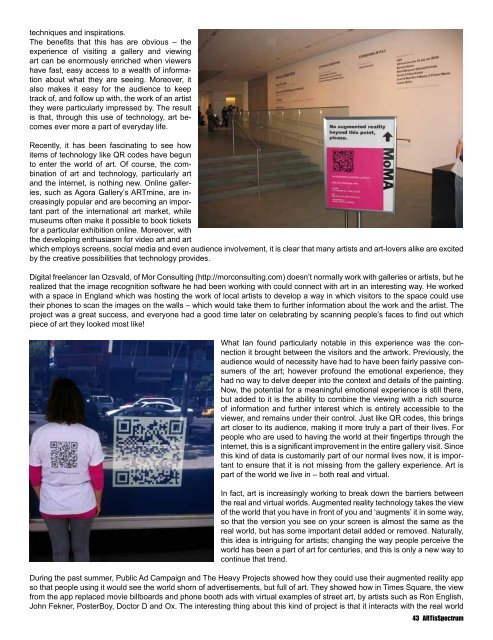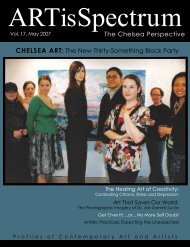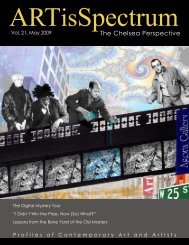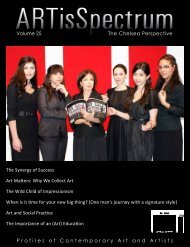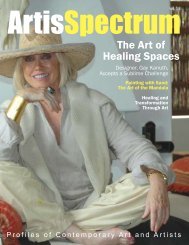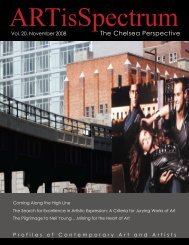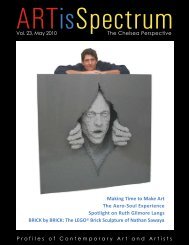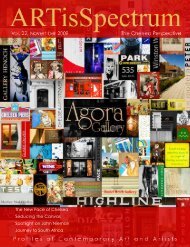Artistic Reality:How art is embracing technology to change the way we see the worldby Karin Maraneyguerrilla exhibition at MoMA, art not ads in Times Square, mysterious black and white squares in Agora Gallery... This isA how technology is changing the art world. Subtle, intriguing and far-reaching, these kinds of developments are altering theway in which we view the world. Ultimately, they insure that art is becoming ever more a part of our lives – and that our lives areincreasingly characterized by our awareness of art.If you visit Agora Gallery you will see that, next to each artist’s work, there is a piece of paper with their name, more about theirwork, their photograph, and a black and white image that looks like a barcode. These are called QR codes, and they are anexample of the way Agora Gallery is always concerned to stay up-to-date with the latest technology which could be valuable inpromoting our talented artists. They were introduced at Agora Gallery on the advice of Artist Agent Laura Di Bello. In this article,you’ll learn more about QR codes and what they’re being used for, as well the ways new technology like these codes are transformingthe art world as we know it.‘QR’ stands for ‘Quick Response’ and that’s exactly what these codes are for. The idea is that they are placed in locations wherethey will be easily noticed, sometimes as part of an advertisement, other times as part of the material about a product. Whenyou see one, you can immediately get out your phone, scan the QR code, and be taken straight to the webpage that will tell youmore about it.They’re increasingly popular – you’ve probably come across hundreds just in the last month or two. They’re great because theyreally are quick response; as soon as you see something you’d like to learn more about, you simply scan the code and then reviewthe page it sends you to. You can use them just for fun, when you happen to be curious and want more information, but they canalso be extremely useful in more practical ways.For instance, if a QR code on a poster has just taken you to the website of an event you would like to go to, you can buy ticketsonline there and then, or bookmark or email yourself the link so that you won’t forget to discuss it later on with friends who mightwant to go with you. You can also email it or share it directly with them. If you’re at Agora Gallery and your attention is caught byan artwork that you can’t stop looking at, all you have to do is scan the QR code on the wall next to the painting, photograph orsculpture, and you have the instant ability to take a look at the artist’s page to see more of their work, and learn more about their42 <strong>ARTisSpectrum</strong>
techniques and inspirations.The benefits that this has are obvious – theexperience of visiting a gallery and viewingart can be enormously enriched when viewershave fast, easy access to a wealth of informationabout what they are seeing. Moreover, italso makes it easy for the audience to keeptrack of, and follow up with, the work of an artistthey were particularly impressed by. The resultis that, through this use of technology, art becomesever more a part of everyday life.Recently, it has been fascinating to see howitems of technology like QR codes have begunto enter the world of art. Of course, the combinationof art and technology, particularly artand the internet, is nothing new. Online galleries,such as Agora Gallery’s ARTmine, are increasinglypopular and are becoming an importantpart of the international art market, whilemuseums often make it possible to book ticketsfor a particular exhibition online. Moreover, withthe developing enthusiasm for video art and artwhich employs screens, social media and even audience involvement, it is clear that many artists and art-lovers alike are excitedby the creative possibilities that technology provides.Digital freelancer Ian Ozsvald, of Mor Consulting (http://morconsulting.com) doesn’t normally work with galleries or artists, but herealized that the image recognition software he had been working with could connect with art in an interesting way. He workedwith a space in England which was hosting the work of local artists to develop a way in which visitors to the space could usetheir phones to scan the images on the walls – which would take them to further information about the work and the artist. Theproject was a great success, and everyone had a good time later on celebrating by scanning people’s faces to find out whichpiece of art they looked most like!What Ian found particularly notable in this experience was the connectionit brought between the visitors and the artwork. Previously, theaudience would of necessity have had to have been fairly passive consumersof the art; however profound the emotional experience, theyhad no way to delve deeper into the context and details of the painting.Now, the potential for a meaningful emotional experience is still there,but added to it is the ability to combine the viewing with a rich sourceof information and further interest which is entirely accessible to theviewer, and remains under their control. Just like QR codes, this bringsart closer to its audience, making it more truly a part of their lives. Forpeople who are used to having the world at their fingertips through theinternet, this is a significant improvement in the entire gallery visit. Sincethis kind of data is customarily part of our normal lives now, it is importantto ensure that it is not missing from the gallery experience. Art ispart of the world we live in – both real and virtual.In fact, art is increasingly working to break down the barriers betweenthe real and virtual worlds. Augmented reality technology takes the viewof the world that you have in front of you and ‘augments’ it in some way,so that the version you see on your screen is almost the same as thereal world, but has some important detail added or removed. Naturally,this idea is intriguing for artists; changing the way people perceive theworld has been a part of art for centuries, and this is only a new way tocontinue that trend.During the past summer, Public Ad Campaign and The Heavy Projects showed how they could use their augmented reality appso that people using it would see the world shorn of advertisements, but full of art. They showed how in Times Square, the viewfrom the app replaced movie billboards and phone booth ads with virtual examples of street art, by artists such as Ron English,John Fekner, PosterBoy, Doctor D and Ox. The interesting thing about this kind of project is that it interacts with the real world43 <strong>ARTisSpectrum</strong>
- Page 1 and 2: ARTisSpectrumVolume 26The Chelsea P
- Page 3 and 4: © Rob Heath Time to Reflect ... Sp
- Page 5 and 6: ARTisSpectrumPublisherAgora Gallery
- Page 7 and 8: ProfilesIf you like to keep up-to-d
- Page 9 and 10: Cade TurnerAustralian artist Cade T
- Page 11 and 12: L. ByrneRed Fireball Oil on Canvas
- Page 13 and 14: When did you realize that you wante
- Page 15 and 16: One Dime Acrylic on Canvas 32” x
- Page 17 and 18: Laurence SteenbergenIce Fruit Acryl
- Page 19 and 20: Joshef MatèIn the work of Joshef M
- Page 21 and 22: Bruce Leslie ThomasBruce in his Stu
- Page 23 and 24: Carlo ProiettoItalian artist Carlo
- Page 25 and 26: Madeleine ArnettParadox 1 Acrylic o
- Page 27 and 28: Cristina Popoviciuring painting,”
- Page 29 and 30: 29 ARTisSpectrum
- Page 31 and 32: The singular landscapes of Italian
- Page 33 and 34: Marty PoorterMarty Poorter’s acry
- Page 35 and 36: John StevensonRenowned Canadian lan
- Page 37 and 38: Early modern men and women, at the
- Page 39 and 40: Norma PicciottoNorma PicciottoL’e
- Page 41: Cristina ArnedoWendy CohenCombining
- Page 45 and 46: Alberto MontoreanoThe Ozone Layer O
- Page 47 and 48: Did you first see the artwork onlin
- Page 49 and 50: Escape from the Cosmic zoo by Aelit
- Page 51 and 52: Agora Gallery’s 27th Annual Jurie
- Page 53 and 54: Nataixa RosLa Tyranie de la Danse O
- Page 55 and 56: Valentino BellucciItalian artist Va
- Page 57 and 58: Jim CobbPhiladelphia artist Jim Cob
- Page 59 and 60: Why an artist needs to go out on ap
- Page 61 and 62: Even when remaining local, and not
- Page 63 and 64: Laila Khan FurniturewallaLaila in h
- Page 65 and 66: Ancient Olive Trees Inspire Artwork
- Page 67 and 68: Ancestral Ghosts, Family Tree 2 Car
- Page 69 and 70: A long wooden table on the terrace
- Page 71 and 72: LaroucheTamara GrizjukLes Belles So
- Page 73 and 74: Igor NelubovichRussian painter Igor
- Page 75 and 76: Thierry FazianEnigmatic Dreams Mixe
- Page 77 and 78: Alison Jane RiceI arrived in the ci
- Page 79 and 80: Catherine Gaillard PerezVisiting Ne
- Page 81 and 82: Richard StuttleLong flight to New Y
- Page 83 and 84: Dominique BoutaudI feel honored to
- Page 85 and 86: VéroniKaHEphémère Stained Glass
- Page 87 and 88: Surrealistic tableaux fill the canv
- Page 89 and 90: How do you decide whether to recomm
- Page 91 and 92: Fred FriedrichFred FriedrichCuadros
- Page 93 and 94:
You might know Mr. Waits from seein
- Page 95 and 96:
Tom Wait’s inventiveness doesn’
- Page 97 and 98:
Patricia Armour has been weaving ta
- Page 99 and 100:
Penelope PaigeHyung Jin ParkViewers
- Page 101 and 102:
Vito MateraVito Matera creates artw
- Page 103 and 104:
Brigitte MartinezBrigitte in her St
- Page 105 and 106:
Building on the artist’s passion
- Page 107 and 108:
Ben FeldshuhFor Brooklyn artist Ben
- Page 109 and 110:
Creating works that bridge cultural
- Page 111 and 112:
Cheri MittermaierCheri Mittermaier
- Page 113 and 114:
Z. TodorovaZ.Todorova in her Studio
- Page 115 and 116:
CLOCKWISEFROM TOP RIGHT:1) Maracaib
- Page 117 and 118:
5761234CLOCKWISEFROM TOP RIGHT:1) S
- Page 119 and 120:
6875123CLOCKWISEFROM TOP RIGHT:1) C
- Page 121 and 122:
Christchurch, New Zealandby Joanne
- Page 123 and 124:
Shanghai, Chinaby Ping HeLocated in
- Page 125 and 126:
Rome, Italyby Monica MorgantiRome,
- Page 127 and 128:
Málaga, Spainby Carmen SotuelaMál
- Page 129 and 130:
Tehran, Iranby Masoud AbediTehran i
- Page 131:
Subscribe to ARTisSpectrumThe Gift


